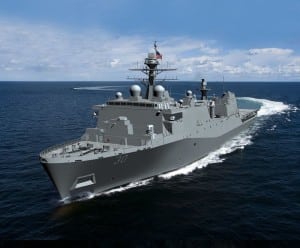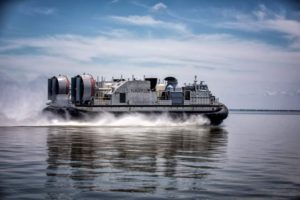The new Light Amphibious Warship (LAW) program for the Navy and Marine Corps is in industry studies and the services are trying to develop it quickly like the FFG(X) frigate, an official said this week.
During the virtual Surface Navy Association Virtual Waterfront symposium on Thursday, Marine Major Gen. Tracey King, Director of Expeditionary Warfare, OPNAV N95 said the Marine Corps is designing a new Light Amphibious Warship.

“Industry studies are ongoing and it’s looking very positive.”
King underscored the LAW does not mean to replace other L-class amphibious ships, but “enhance the ability of the fleet to conduct distributed operations” as part of the service’s expeditionary advance base operations (EABO) concept along with general distributed operations in the future.
“If we are going to be distributed in the opening gambit with an adversary, we also need to ensure these individual platforms have increased lethality. So my opinion is….if it floats it fights.”
King said the Navy and Marine Corps “need to build an affordable ship that can get after the ability to do maritime campaigning in the littorals” but at the same time he sees the need to have it operational quickly.
“So not forcible entry, not the ability to replace the L-class ships, it’s going to be additive. But it is going to be affordable. So what that means is she really needs to know what’s going on and she needs to have a sheepdog watching out for her. That might be an LPD-17, it might be a DDG Flight 3, it might be an LCS, depending upon what the fleet commander sees as the situation. But I see the efficacy of this LAW, how it’s going to help us out, is really going to be in the phase and stage that we’re in right now.”
King argued he thinks the U.S. is in the pre-conflict phase with potential adversaries like China so the Navy and Marine Corps need to start doing things differently.
“I think we’re late to need with building the Light Amphibious Warship, which is why we’re trying to go so quickly.”
King said his team copied what Rear Adm. Paul Schlise, Director of Surface Warfare’s team, went through with planning the new FFG(X) frigate program. “We literally just patterned it right after – we were able to get through the requirements evaluation process, developing the top level requirements, and now we’re in the industry studies quickly,” he said.
More generally for EABO, King sees it calling for Marines to return to their roots.
“We’re going to have Marines out there sinking ships. I’ve even talked to our undersea guys about Marines out there sinking submarines so some of our inside forces can stay hidden. And let our adversary worry about me and my hundred guys running around crazy on some island instead of these capital assets that are really the heart and soul of the joint force.”
King said LAW is a prime example of what the force is investing in and is different from current vessels.
He said he has been asked why can’t the Marines just operate on connectors, especially as the Navy is now buying replacement landing craft vessels.
King argued technically they can, but the LAW will go beyond Landing Craft Utility (LCU) vessels.

“The LAW is going to be a lily pad that carries excess fuel, that can make water, that can talk, that’s under the umbrella of the fleet, that Marines can actually live on. I see them as part of the crew. I see these LAWs as part of Marine organizations and those larger Marines organizations as being part of the Expeditionary Strike Group.”
During an Aug. 27 press call, Navy acquisition chief James Geurts explained the fiscal year 2021 budget proposed some money to start refined activities for LAW.
He said the team is starting to dial in and “everybody’s aligned on where we’re trying to go and now we’re in the refinement process there which will then lead to the acquisition strategy and how we’ll approach it programmatically.”
Geurts said this process is not particularly hurt by delay in the release of a Final Force Structure Assessment or 30-year shipbuilding plan.
The Office of the Secretary of Defense is working on a more top-level naval force structure study and architecture.
Geurts argued that process “takes into account things we believe that we’ll need in the future as well as attributes of anything else that we may want to add into the architecture. So I would say it’s considered in there and part of that future look.”
As the naval force structure study get finalized and then released, “we’ll use that to inform our acquisition plan ahead for things like LAW,” he added.